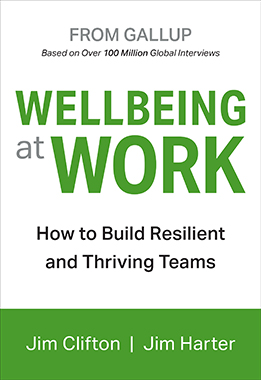Story Highlights
- Talented workers are leaving for workplaces with higher wellbeing
- Leaders can improve wellbeing for their employees
- Career wellbeing is the foundation for thriving in all wellbeing elements
The Society for Human Resource Management calls it the "turnover tsunami." Texas A&M Professor Anthony Klotz coined it "the great resignation." Whatever term you use, the recent mass exodus of talent sparked by rebounding economic activity has organizations in a frenzy to keep their best people.
Now more than ever, people are evaluating their lives and how and where they invest their energy -- and they want an employer that supports the lifestyle they aspire to.
Many talented workers are leaving for workplaces that align with their personal belief system and show an authentic concern for individual employee wellbeing. People want a good job and a life well-lived. With record-high resignations and a labor shortage, some leaders now realize that they need to provide more than check-the-box wellness programs and perks to retain their best.
Many talented workers are leaving for workplaces that align with their personal belief system and show an authentic concern for individual employee wellbeing. People want a good job and a life well-lived.
In fact, Gallup recently asked employees what they look for most in an employer. The data showed that employees of all generations rank "the organization cares about employees' wellbeing" in their top three criteria. For millennials and Generation Z, it's their No. 1 workplace want. Also high on their list are diversity, equity and inclusion (DEI) and ethical corporate behavior.
Wellbeing is about how our lives are going. It encompasses all the things that are important to each of us and how we experience our lives. It's not only about happiness and health but also about living life to its fullest potential. Historically, most workplaces haven't considered themselves responsible for supporting or enhancing workers' wellbeing outside of providing compensation and benefits.
Today, workplaces that want to compete for talent know they can't depend on the status quo: Employees now expect a real commitment to supporting thriving lives from leaders. That is, it's imperative for leaders to not only care for but also actually improve their employees' wellbeing.
This need to improve wellbeing has never mattered more. Worldwide, employees' daily stress climbed to 43% in 2020 -- and was much higher, at 57%, in the U.S. and Canada -- as reported in Gallup's State of the Global Workplace 2021 Report. The findings in this report indicate that we are in the middle of a global mental health crisis that will only intensify without broadscale intervention.
Wellbeing is about how our lives are going. It encompasses all the things that are important to each of us and how we experience our lives. It's not only about happiness and health but also about living life to its fullest potential.
The Solution Is Your Culture
Many factors influence employees' wellbeing and stress, but one major contributing factor is within leaders' control: their work culture.
Too often, leaders fall into the wellbeing "perks and policies" trap, wondering why their people are burned out and stressed despite access to fringe benefits like on-site massages and treadmill desks. In Gallup's experience, leaders can transform employee wellbeing -- and build exceptional employer brands -- when they focus on the way work gets done and employees' day-to-day experiences, or in other words, their culture.
Leaders of net thriving work cultures are committed to wellbeing values and have employees' best interests at heart. A net thriving work culture provides engaging work, strong relationships, financial security, high energy and opportunities to give back.
As a result, net thriving work cultures are more innovative, agile and customer-oriented -- and they are magnets for top talent.
In fact, recent Gallup meta-analytic studies have shown that cultures with effective work-life integration, growth opportunities and perceptions of fair pay are best positioned to retain talent.
Without question, culture begins at the top. Wellbeing becomes part of the culture when leaders and managers champion expected norms to help employees feel comfortable making decisions that align wellbeing with business outcomes.
The Five Elements of Wellbeing
To create a net thriving culture, leaders need to understand wellbeing and what it takes to enhance the quality of employees' lives.
Gallup scientists have been exploring the demands of a life well-lived since the mid-20th century. In the early 2000s, Gallup began to explore the common elements of wellbeing that transcend countries and cultures in partnership with leading economists, psychologists and other acclaimed scientists.
Through that research, Gallup identified five elements of wellbeing: career, social, financial, physical and community.
The five elements are actionable antecedents to wellbeing that deliver positive personal and business outcomes, including decreasing stress, increasing resiliency and adaptability, improving job performance, and reducing turnover. A winning wellbeing strategy is holistic: It acknowledges that business performance depends on all five elements of employee wellbeing.
Career wellbeing: You like what you do every day.
Organizations that limit their wellness programs to healthy eating and exercise make a grave error. But Gallup's research finds that the element that has the greatest impact on positive outcomes is career wellbeing: It's the foundation for thriving in all five elements.
Leaders should focus on employees' unique strengths to create a culture of high development and help employees achieve real career progression in a way that is meaningful to them, which doesn't have to be a promotion to the next level. Manager development is also vital: In a net thriving culture, managers are experts at setting wellbeing goals and asking employees about their wellbeing during ongoing career development conversations.
Gallup's research finds that the element that has the greatest impact on positive outcomes is career wellbeing: It's the foundation for thriving in all five elements.
Social wellbeing: You have meaningful friendships in your life.
Every individual has a need to feel connected, and employees' social relationships influence their engagement, performance and overall wellbeing.
Leaders can support social wellbeing by creating consistent opportunities for people to get to know one another through work. For example, they could host cross-departmental events to give people the chance to connect and build relationships with coworkers they might not normally work with. Scheduling events during normal working hours, rather than after hours, give all employees a chance to participate.
Financial wellbeing: You manage your money well.
The opinion that an organization is responsible for an individual's financial wellbeing can breed contention. But leaders should think about it differently: Financial wellbeing is about financial security and people's perceptions of their financial status.
People with high financial wellbeing feel like they have enough money for the things that are important to them.
Leaders can help by providing tools, training and support programs that help people make wiser financial decisions such as 401(k) resources and advice about living within their means. Further, leaders should convey their commitment to fairness, audit their compensation practices and prepare managers to have effective pay conversations.
Physical wellbeing: You have energy to get things done.
Tragically, the pandemic exposed the dangers of poor physical wellbeing. It's no surprise that employees with thriving physical wellbeing are more likely to bounce back after illnesses and injury than those who are not thriving. Importantly, holistic wellbeing matters: Employees thriving in all five elements are 36% more likely to report a full recovery after an illness, injury or hardship versus those thriving in physical wellbeing alone.
Organizations should consider how well their culture encourages -- or impedes -- physical wellbeing. For instance, an on-site gym is pointless if employees' workloads prevent them from using it. In contrast, walking meetings during the workday might be a part of a net thriving culture.
Community wellbeing: You like where you live.
Community wellbeing is about giving back and making meaningful contributions where you live. To support this important element, leaders should identify the community issues that matter most to their employees and align with their organization's core values.
Leaders armed with these insights can connect employees with customized opportunities that connect skills and passion to local needs (like bringing together female engineers and scientists with girls in STEM programs). And to generate awareness and enthusiasm, give employees opportunities to share the impact they're creating in the community with their coworkers.
Embarking on a journey to create a net thriving organizational culture can seem like an impossible feat. Leaders must take the first step by answering a simple question: How many of my employees are thriving? While there is an increasing amount of progressive, exceptional workplaces tracking this, most organizational leaders simply do not know the answer to this question.
Gallup has worked with organizations to help them better understand their employees' wellbeing to create targeted, meaningful, effective decisions that truly improve not only people's lives but also the business in the process.
For example, one part of a continuous listening strategy that many organizations are expanding in 2021 is the employee stay survey. Stay surveys and interviews identify employees' motivations to stay with your organization and uncover possible intentions to leave. Done correctly, they have a positive focus, expose triggers and build trust. When Gallup partners with organizations to design and integrate a stay program, we evaluate wellbeing factors to determine what matters most to employees and how leaders and managers can support those wellbeing priorities.
Leaders need to isolate their wellbeing strengths and opportunities by listening to their people throughout the employee experience -- from attraction to departure. As the foundation of the employee experience, wellbeing has a major influence over employees' ability to do great work and an additive effect on employee engagement. Regardless of your type of culture, incorporating wellbeing into your continuous listening strategy can remove barriers to high performance.
Every organization today is somewhere on its journey to creating a thriving wellbeing culture. The best recognize that a net thriving culture is more than just a glowing endorsement on Glassdoor. Employees want the purpose of your organization to inspire them to deliver something bigger than themselves.
Want your top talent to stay? Focus on wellbeing.
- Download our State of the Global Workplace: 2021 Report to learn more about the mental health crisis the world is facing.
- Don't let poor wellbeing cost you your best employees. Learn how to create a culture where every employee's wellbeing thrives.





